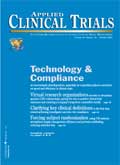eClinical Trials: Planning & Implementation
Applied Clinical Trials
eClinical Trials: Planning & Implementation is a useful resource for those new to the industry as well as practitioners already involved in planning and implementing eClinical trials.
Rebecca Daniels Kush, with Paul Bleicher, Wayne R. Kubick, Stephen T. Kush, Ronald Marks, Stephen A. Raymond, and Barbara Tardiff (Thomson CenterWatch, Boston, MA, 2003), 200 pages, soft cover, ISBN: 1-930624-28X, $79.00.
This manual, according to its publisher, is the first-of-its-kind resource for biopharmaceutical companies, CROs, and investigative sites searching for guidance in implementing technology to accelerate and improve their clinical trials. The authors claim there is a great need for assistance in this area, particularly when one compares the progress of the financial community to the healthcare industry. Healthcare is clearly lagging behind, and most physicians do not even have electronic access to patient records. While it is unreasonable to expect the entire industry to move en mass to a paperless delivery system, clinical trials, say the authors, are a prime candidate for improvement.
Sponsors and CROs indicate that they are using eClinical technologies for 24% of phase 1–4 trials (up from 12% in 2000), and they anticipate using eClinical technologies for nearly half of their clinical projects by 2004 according to a 2002 CenterWatch/CDISC research project cited in the book involving approximately 750 organizations. However, more widespread implementation can lead to roadblocks. Proponents of eClinical trials face a myriad of hurdles, including disparate data systems, the lack of a link between healthcare data and clinical trial data, real and perceived regulatory risks, and, according to the authors, “the overall slowness of adoption that is characteristic of the pharmaceutical industry.”
The important topics that this book covers are: The Optimal Electronic Clinical Trial; Process Redesign and Supporting Technologies; Achieving eClinical Trials; Metrics for Electronic Clinical Trials; Performing Electronic Clinical Trials in accord with Regulations; Data Quality and Data Integrity; The Impact of eClinical Trial Technology on Safety and Surveillance and IRBs; Industry Data Standards; and Ensuring the Success of Electronic Clinical Trial Implementations.
Organizationally, the book benefits throughout from graphically distinguished “Notes” stressing important points and highlighting relevant research. Other favorable features of the book include flowcharts detailing current, paper-based clinical trial processes and eClinical trials. The book’s Appendix also adds value, particularly the Glossary, which, although offering very basic terms, also includes electronic terminology such as “Health Level Seven (HL7),” an application protocol for electronic data exchange in healthcare environments. The Traceability Matrix, which covers compliance to 21 CFR 11 rules involving electronic records, is another useful aspect of the Appendix.
In another section of the book—Guidance for Industry: Computerized Systems Used in Clinical Trials—issues pertaining to computerized systems used to create, modify, maintain, archive, retrieve, or transmit clinical data to the FDA are also addressed.
The book is a useful resource for those new to the eClinical trials industry as well as those already involved in planning and implementing eClinical trials.
The book’s accomplished authors include Rebecca Daniels Kush, PhD, a founder and current president of the Clinical Data Interchange Standards Consortium (CDISC).

Behind the Buzz: Why Clinical Research Leaders Flock to SCOPE Summit
February 7th 2025In this episode, we meet with Micah Lieberman, Executive Conference Director for SCOPE Summit (Summit for Clinical Ops Executives) at Cambridge Innovation Institute. We will dive deep into the critical role of collaboration within the clinical research ecosystem. How do we bring together diverse stakeholders—sponsors, CROs, clinical trial tech innovators, suppliers, patients, sites, advocacy organizations, investors, and non-profits—to share best practices in trial design, program planning, innovation, and clinical operations? We’ll explore why it’s vital for thought leaders to step beyond their own organizations and learn from others, exchanging ideas that drive advancements in clinical research. Additionally, we’ll discuss the pivotal role of scientific conferences like SCOPE Summit in fostering these essential connections and collaborations, helping shape the future of clinical trials. Join us as we uncover how collective wisdom and cross-industry partnerships are transforming the landscape of clinical research.
Reaching Diverse Patient Populations With Personalized Treatment Methods
January 20th 2025Daejin Abidoye, head of solid tumors, oncology development, AbbVie, discusses a number of topics around diversity in clinical research including industry’s greatest challenges in reaching diverse patient populations, personalized treatment methods, recruitment strategies, and more.
Phase III Trial Data Show Subcutaneous Pembrolizumab as Noninferior to IV Keytruda
March 31st 2025Subcutaneous administration of pembrolizumab with chemotherapy demonstrated a nearly 50% reduction in patient chair and treatment room time while maintaining efficacy and safety endpoints compared to intravenous Keytruda.
Phase II ALPACA Trial Shows Lepodisiran Produces Significant, Sustained Lipoprotein(a) Reductions
March 31st 2025Eli Lilly’s lepodisiran, an investigational siRNA therapy, achieved significant and durable reductions in lipoprotein(a) levels, a major genetic risk factor for cardiovascular disease.